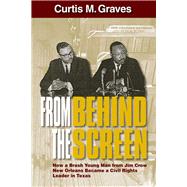From Behind the Screen How a Brash Young Man from Jim Crow New Orleans Became a Civil Rights Leader in Texas
, by Graves, Curtis M- ISBN: 9780935437614 | 0935437614
- Cover: Paperback
- Copyright: 3/11/2024
It was into the native creole culture of New Orleans and Louisiana that Curtis Graves was born. This is unique mixture of former slaves, free people of color, American Indians and Europeans – all in just about any combination you can imagine.
Regardless of the mixture, they were considered “ colored.” Even in the Catholic churches that allowed both races to pray, parishioners expected that they would sit in separate pews.
Then there was the “ screen,” New Orleans’ name for the gamut of “ Colored Only” signs that were ubiquitous in the city.
Curtis’ family hid from him the most obvious signs of restrictions placed on their lives. As he became older Curtis was allowed to come to his own understanding.
First attending college close to home, Curtis transferred to Texas Southern University in Houston, a large historically black college. It was a time when even more attention was being paid to the burgeoning civil rights movement. Dr. Martin Luther King, Jr. had emerged as its leader,.
The young students at Texas Southern took notice. Curtis and others decided to protest in their own way – demanding equal access to public places. The first target was the lunch counter at a Houston drug store.
It made the national news and Graves’ parents were not happy. He made them realize that they had brought him up to take a stand.
By the time Graves entered the Army, he already earned a reputation for political activism. Returning to Texas, he ran for a seat in the Texas State Legislature. Curtis Graves won, becoming one of the first African Americans to hold office since Reconstruction.
He served six years--and ran a vigorous campaign for Mayor of Houston, but even after he left office — and politics — Graves has never stopped battling for fairness and equal opportunity.
He tells his story with real style, remembering with warmth and good humor all the people – both famous and not so well-known — who have touched his life along the way. Even more, he gives us an important first hand understanding of the struggles for Civil Rights in America.






